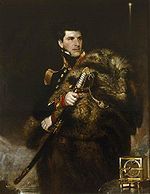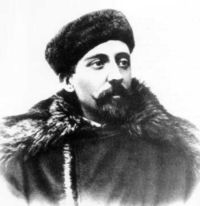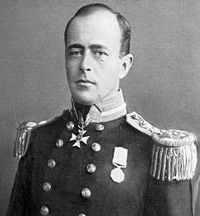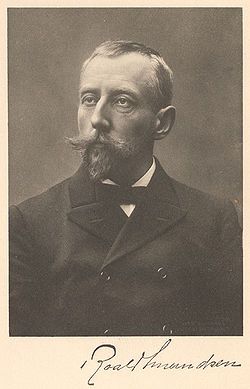Today is my first real day off! I did have a day off when I first arrived but Stacy was kind enough to take us on an all day field trip (it was really fun). This is the first day that I have absolutely nothing to do. Of course, I slept a little later (9:00am) and then after a yummy brunch I did lots of little errands. I decided that the thing I needed the most was to rest. I still have fever blisters and I don't think that they are healing because I am not getting enough rest (oh the price we pay to have fun). So I spent the day reading and taking cat naps. I did try to do some work on the computer but I couldn't figure out to get internet in my dorm room. I think I made a good decision to rest, even though I would have liked to take a hike around McMurdo. Well, maybe on my next day off.I thought that this would be a good time to give you a little history of the exploration of Antarctica. It really is an interesting story and I hope that you will enjoy hearing about the brave people that helped bring this amazing continent to the attention of the rest of the world.
It all began about 350 B.C. when the Greeks first came up with the idea of Antarctica. They knew that the Arctic existed and had named it after the constellation "The Bear" (Arktos). The Greeks figured that there had to be a similar place in the South and that it would be the opposite of the Arctic. They decided to call it "opposite The Bear" or Ant-Arktos. This was all based on supposition.
In 1773 James Cook crossed the Antarctic Circle and circumnavigated Antarctica. However, he never sighted land.
 He was also the first European to visit the Hawaiian Islands.
He was also the first European to visit the Hawaiian Islands.
The first person to actually see the continent of Antarctica was a subject of much debate for years. In January of 1820 Captain Fabian Gottlieb von Bellingshausen, an officer aboard the Russian vessel Vostok (now the name of the Russian station on Antarctica) became the first to actually see Antarctica. Later that month British naval officers William Smith and Edward Bransfield saw Antarctica and in November Nathanial Palmer became the first American to lay eyes on the continent of Antarctica. This was the first time that a continent had been discovered.
 He commanded the second Russian expedition to circumnavigate the globe.
He commanded the second Russian expedition to circumnavigate the globe.
The first person to actually land on Antarctica was an American named Captain John Davis. It was February of 1821 and he had been searching for seals. Later that year a group from the British ship Lord Melville became the first to spend a winter in Antarctica.
In 1823 James Weddell discovers a sea and reaches the southerly most point of Antarctica. The sea was later named the Weddell Sea and it was 80 years before someone else managed to reach it.
 The Weddell Sea, the Weddell Islands, and the Weddell seal were named after him.
The Weddell Sea, the Weddell Islands, and the Weddell seal were named after him.
In 1841 James Clark Ross, a British naval officer, took the ships, Erebus and the Terror to within 80 miles of the coast. He was stopped by a large ice barrier that we now call the Ross Ice Shelf. He discovered an active volcano and named it after his ship (Erebus) and the ship's scientist identified 145 new species of fish. The Ross Sea was also named after this officer.
 He discovered the Ross Sea, Victoria Land, and the volcanoes Mount Erebus and Mount Terror, which were named for the expedition's vessels.
He discovered the Ross Sea, Victoria Land, and the volcanoes Mount Erebus and Mount Terror, which were named for the expedition's vessels.
In 1898 Adrien de Gerlache and the crew of the Belgica become trapped in pack ice off the Antarctic Penisula. They had been on the first scientific expedition to the continent and instead became the first to survive an Antarctic winter as their ship drifted with the ice.
 He also participated in expeditions to Greenland, the Persian Gulf, and an aborted second one to Antarctica.
He also participated in expeditions to Greenland, the Persian Gulf, and an aborted second one to Antarctica.
The first group to actually land on the continent was a British expedition led by Carsten Borchgrevink. In 1899 the group landed at Cape Adare and built huts.
 He was not toreceive recognition for his deeds until much later in his life.
He was not toreceive recognition for his deeds until much later in his life.
In 1902 Captain Robert Falcon Scott led his first Antarctic expedition to reach the South Pole. His men included Ernest Shackleton and Edward Wilson. Two months after the expedition began they were forced to turn back.
 In the dozen years following the disaster more than 30 monuments and memorials were set up in Britain alone to Scott and his men.
In the dozen years following the disaster more than 30 monuments and memorials were set up in Britain alone to Scott and his men.
Shackleton led another expedition known as the Nimrod Expedition from 1907-1909. He was within 97 miles of the South Pole when he was forced to again turn back. He had run out of supplies.
 He has in recent years become a role model for leadership as one who, in extreme circumstances, kept his team together to accomplish "an incredible survival story".
He has in recent years become a role model for leadership as one who, in extreme circumstances, kept his team together to accomplish "an incredible survival story".
In January of 1909 Douglas Mawson, an Australian, became the first person to reach the South Magnetic Pole (the wandering point on the Earth's surface where the geomagnetic field lines are directed vertically upwards).
 He was a key expedition leader during the Heroic Age of Antarctic Exploration.
He was a key expedition leader during the Heroic Age of Antarctic Exploration.
It was Roald Amundsen from Norway who became the first person to reach the Geographic South Pole (the southernmost point on the surface of the Earth). His five man expedition accomplished this fete in 1911.
 He was the first person to reach both the North and South Poles.
He was the first person to reach both the North and South Poles.
Captain Robert Scott reached the South Pole in January of 1912. His entire five man expedition perished on the return journey. They were only 11 miles from the supply depot. Later that year Douglas Mawson discovered a new section of the coast and this was the first time that radio was used in Antarctica.
Shackleton returned to Antarctica in 1915 to attempt the first crossing of the continent. He was unsuccessful but it was an amazing journey (I would definitely look this one up). The entire party was eventually rescued in 1917.
In 1928 an Australian by the name of Sir George Wilkins and the American Carl Eielson became the first men to fly over Antarctica. In 1929 the American Richard Byrd and his three companions became the first to fly over the South Pole.
Caroline Mikkelsen from Norway became the first woman to set foot on Antarctica. She was travelling with her husband, a whaling captain.
The largest expedition to Antarctica was sent in 1947 by the United States. It included 4700 men, 13 ships, and 23 airplanes. One of their primary duties was to map the region and it was known as Operation Highjump.
In 1956 the United States lands an airplane at the South Pole and become the first people to do so since Scott and his team in 1912.
Between July of 1957 and December of 1958, twelve nations establish a total of 60 stations in Antarctica. Vivian Fuchs, a British geologist, and Sir Edmund Hillary from New Zealand successfully complete a land crossing to the South Pole. This was the first time this had been done. In 1961 the Antarctica treaty became effective.
Antarctica is the only continent on Earth that does not possess a native human population. It is defined as all land and ice shelves south of the 60°S latitude parallel. The treaty has been signed by 46 countries and establishes Antarctica as a scientific preserve. Any military action is banned.
Boerge Oulan of Norway became the first person to cross Antarctica without any support. It took him 64 days in 1997 to go from Berkner Island to Scott Base.
We are currently in the International Polar Year. It runs from March 2007 to March 2009. It actually covers two years in order to give researchers the opportunity to work in both polar regions if they wish.
This is a simple overview of the history of Antarctic exploration. There have been over 300 expeditions to the mainland alone. It is a history that is rich with adventure and bravery and one that you should take the time to explore further.
Today I am going to skip the "Polar Profile of the Day" (after all I am on a break too). I would like to share with you some books that Stacy recommended to the team. If you want to read about the history of Antarctica, then try Worst Journey in the World by Apsley Cherry Gerard or South: The Last Antarctic Expedition of Shackleton and the Endurance by Sir Ernest Shackleton and Tim Cahill. If you would like to see some pictures of this beautiful continent, then try Antarctica: A Year at the Bottom of the World by Jim Mastro. Lastly, if you are interested in life on the ice try one of Stacy's favorite books, Terra Incognita by Sara Wheeler. Happy reading!

